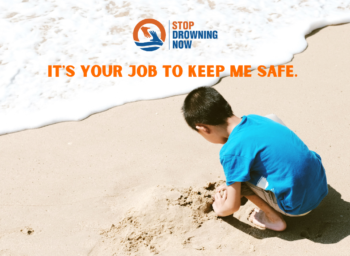
14 Ways To Keep Your Toddler Safe
Toddlers—curious, energetic explorers—are attracted to water. It’s not surprising that water tables are one of the most popular toddler toys on the market. Water is fun, it shimmers and ripples, and you can splash in it and use it to fill things. From a toddler’s point of view, what’s not to like? They’re too young to understand that water can also be dangerous. Drowning is the leading cause of injury-related death for those 1 to 4 years of age.
All It Takes is 10 Seconds and a Couple of Inches of Water
When it comes to water dangers, curiosity isn’t the only disadvantage toddlers have. Drowning can happen quickly and quietly. A toddler’s head is disproportionately larger than their body, making it heavy. So, if their head goes into the water, it’s difficult for them to lift it, and if their nose and mouth are in the water, it can get into their airway, and they can drown. When a child is drowning, and there’s water in their airways, they can’t speak or call for help.
Water Dangers for Toddlers are Everywhere
Although home swimming pools are where most children under the age of four drown, there are plenty of other places in and around homes that are also dangerous. For example, children under one year of age most often drown in a bathtub, toilet, or bucket. The biggest drowning threat facing families with toddlers is unexpected, unsupervised access to water in all kinds of places: swimming pools, hot tubs, and spas, bathtubs, natural bodies of water such as ponds, toilets, buckets, and standing water in homes.
Distractions can lead to Tragedy
In the time it takes to look in your bag for your phone, search for sunscreen, slather your hot dog with mustard, or send a quick text message, your child could drown. The simple reality is that the only way to keep children safe in and around water is constant supervision. We like to convince ourselves that we can multi-task, but we can’t. Remember, it only takes seconds for disaster, so if you’re on your phone, reading a book, or having a conversation, you can’t effectively watch kids in the water.
14 Ways to Protect Your Toddler from Drowning
Residential swimming pools and spas
To ensure water safety in a home pool or spa:
1. Learn to swim.
As a parent, it’s imperative to remember that there’s no substitute for active adult supervision of your kids around water. But an important line of defense for your children is having the ability to swim on their own. In fact, according to the CDC, swim lessons can reduce the rate of drowning by 88%.
If your toddler is not already enrolled in swim class, there’s no better time than the present to get them started. The AAP recommends swim lessons as a layer of protection against drowning that can begin for many children starting at age 1.
2. Fence it in.
Install a fence at least four feet tall to separate the pool area from the house and yard. Toddlers are small, clever, and curious, so make sure they can’t slip through vertical slats by ensuring that the gaps are no wider than four inches, the fence isn’t more than four inches off the ground, and it’s not easily climbed.
Ensure the fence doesn’t block the view of the pool from outside the fenced area, so you have a clear view. Install self-closing and self-latching gates that open away from the pool area with latches beyond a child’s reach.
3. Install alarms.
No matter how vigilant you are, it’s nearly impossible to see everything. Use an alarm on the house door that leads to the pool area, a floating pool alarm, or a below-water alarm in the pool. An alarm isn’t a substitute for appropriate fencing and supervision, but it can help.
4. Remove toys.
Those colorful pool toys can be very enticing to a young child, and they can slip and fall into the water trying to retrieve a toy, so make sure you remove them from the water when the pool’s empty. To be extra safe, store them, so they’re not visible.
5. Keep wheels away from the water.
Keep the pool area clear of bikes, tricycles, scooters, skateboards, and roller skates because they can easily swerve or skid, causing a child to fall into the pool accidentally and drown. The weight of these items can trap children underwater.
6. Avoid alcohol.
Sure, a cold beer on a hot summer day sounds good, but if you’re swimming or supervising children who are swimming or playing in the water, it’s not a good idea.
7. Keep emergency equipment handy.
Always have emergency equipment accessible, a life ring with a rope, shepherd’s crook, or a reaching pole. You should always have a phone in the pool area in case of an emergency.
8. Block pool and hot tub access.
Cover the pool with a rigid, motorized safety cover to block access to the pool when it’s not in use. Secure a cover on hot tubs. Don’t allow water to collect on top of the pool or hot tub cover. Always remove above-ground pool steps or ladders or lock them behind a fence when the pool isn’t in use. Make sure to empty inflatable pools after each use.
9. Beware of drains.
Make sure children don’t play near or sit on pool or hot tub drains. It’s very easy for body parts and hair to become entrapped by the strong suction. You can also purchase specially designed drain covers, safety vacuum-release systems to prevent entrapment.
10. Know CPR.
Knowing how to respond in an emergency is mandatory. Everyone, including parents, caregivers, and older children, should learn cardiopulmonary resuscitation (CPR). Check out area organizations, such as the American Red Cross, fire departments, and hospitals to find CPR certification courses.
Toilets, Bathtubs, and Buckets
A baby can drown in just a couple of inches of water. A curious toddler can fall into a toilet, bucket and quickly slip in a bathtub. Consider these precautions:
11. Keep the bathroom door closed.
It may seem like overkill, but installing a safety latch or doorknob cover on the outside of the bathroom door can potentially save you from heartache.
12. Supervise bath time.
Let the phone ring; they’ll call back. Never leave a child alone in the bathtub or the care of another child. Always drain water from the tub immediately after use.
13. Shut toilet lids.
Remember those cute but large toddler heads. It’s easy for a toddler to topple into a toilet. Consider installing childproof locks on lids.
14. Store buckets safely.
As tempting as it may be to promise yourself you’ll get to it later, empty buckets and other containers immediately after use. Don’t leave them outside, where they can accumulate water.
The good news is drowning is preventable. When it comes to keeping your young child safe in and around the water, the bottom line is supervision. You are your child’s best protection. Always keep young children within arm’s reach to prevent the unthinkable. Check out our programs and join the effort to ensure that everyone is safe!



